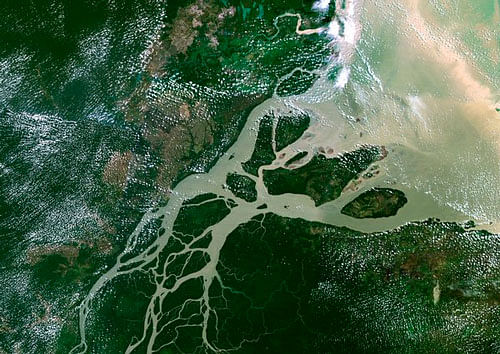
Scientists have discovered a new reef system at the mouth of the Amazon River, the largest river by discharge of water in the world.
As large rivers empty into the world's oceans in areas known as plumes, they typically create gaps in the reef distribution along the tropical shelves - something that makes finding a reef in the Amazon plume an unexpected discovery.
Scientists from University of Georgia (UGA) in US and the Federal University of Rio de Janeiro in Brazil on a recent expedition to study the Amazon River plume looked for evidence of a reef system along the continental shelf.
The Amazon plume - an area where freshwater from the river mixes with the salty Atlantic Ocean - affects a broad area of the tropical North Atlantic Ocean in terms of salinity, pH, light penetration and sedimentation, conditions that usually correlate to a major gap in Western Atlantic reefs.
"Our expedition into the Brazil Exclusive Economic Zone was primarily focused on sampling the mouth of the Amazon," said Patricia Yager, an associate professor at UGA.
The team used multibeam acoustic sampling of the ocean bottom to find the reef and then dredged up samples to confirm the discovery.
"We brought up the most amazing and colourful animals I had ever seen on an expedition," Yager said.
The Amazon River plume and its effects on the global carbon budget converged with the discovery of the reef system to provide scientists a wider view of the reef community, its variation and changes.
Microorganisms thriving in the dark waters beneath the river plume may provide the trophic connection between the river and the reef.
"The paper is not just about the reef itself, but about how the reef community changes as you travel north along the shelf break, in response to how much light it gets seasonally by the movement of the plume," said Yager.
"In the far south, it gets more light exposure, so many of the animals are more typical reef corals and things that photosynthesise for food," she said.
"But as you move north, many of those become less abundant, and the reef transitions to sponges and other reef builders that are likely growing on the food that the river plume delivers," Yager said.
However, the reefs may already be threatened, researchers said.
"From ocean acidification and ocean warming to plans for offshore oil exploration right on top of these new discoveries, the whole system is at risk from human impacts," she said.
The study was published in the journal Science Advances.